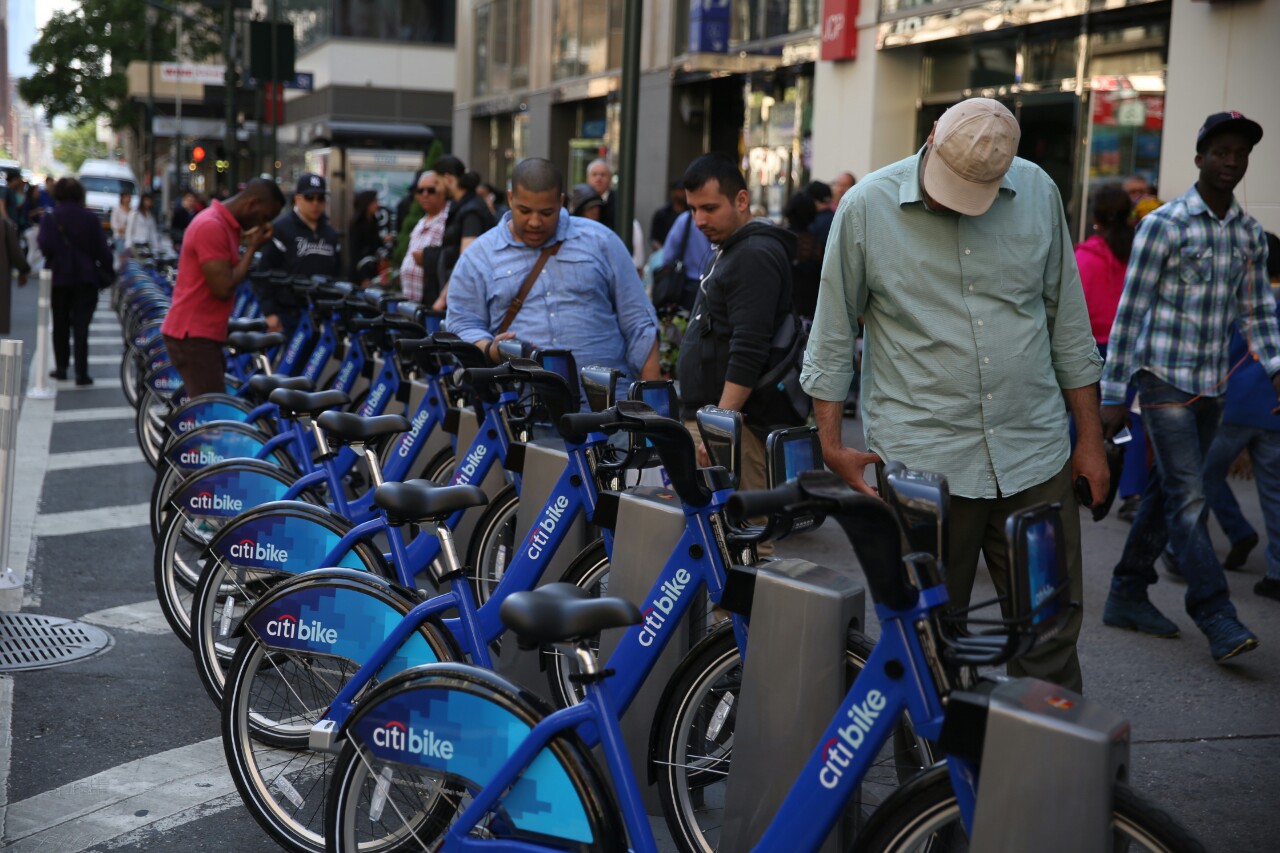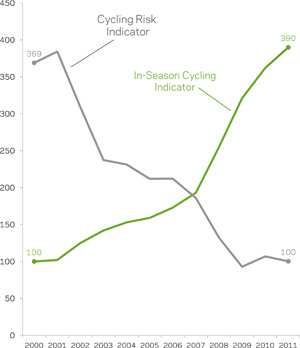
Walk up to an intersection in Manhattan, or parts of Brooklyn, and it may look different than it did five years ago. You may notice that there are more bicycles, specifically more blue rented bicycles. Since the Citi Bike Share Program kicked off about a year ago, it has expanded dramatically. The program added 4,000 bikes after just 4 months and averages 40,000 trips daily in good weather and almost 10,000 trips daily in cold months.
Many experts had argued that increased bike use would also lead to an increase in cycling accidents. However, the Citi Bike Share Program kicked off about a year ago and a study by Hunter College found just the opposite, namely that Citi Bike riders are much less likely to be involved in accidents than other riders. Dr. Peter Tuckel, a professor in the Sociology Department at Hunter College who participated in the research on the Citi Bike program, says, “Everybody had predicted with the Citi Bike rides that there would be a spike in the number of accidents…I think it was the same people that predicted that the Broncos were going to win the Super Bowl. It didn’t materialize.” Strangely, Citi Bike users are also much less inclined to wear helmets. While this might at first seem counter-intuitive, some possible explanations include the type of people who ride Citi Bikes, their skill level, the shorter distances that they ride, and better maintenance of Citi Bikes.
According to a November New York Times article there was not one death or major injury involving a Citi Bike during the first five months and five million trips of the program, while other general cyclists in New York City faced an annual death rate of 11 in both 2012 and 2013, as well as a much greater risk of serious injury. Both nationally and internationally, other cities with bike-share programs have experienced similar positive results.
One idea for why Citi Bikes are working so well is “safety in numbers.” With the large increase in cyclists, drivers are more aware of cyclists and prepared to encounter a Citi Bike at every corner. This notion of Citi Bike safety, in turn, increases bike-share ridership and leads to a self-reinforcing phenomenon of increased safety and increased ridership for Citi Bike. Tuckel says, “Drivers are becoming more aware of cyclists, and cyclists are becoming more aware of drivers. It’s going to result in safer habits for drivers and cyclists.” In addition to this being great news for Citi Bikers, it also led to an overall decrease in the injury/death rate for all New York City cyclists in 2013 compared to previous years.

http://www.nyc.gov/html/dot/html/bicyclists/bikestats.shtml
The study done at Hunter College also recognized that Citi Bike riders are remarkably law abiding. In part this may reflect the fact that the Citi Bike program disproportionately attracts women cyclists. The proportion of women riding bicycles was 21.1 percent of riders in the general population (in 2009) but is 31.1 percent among Citi Bikers. Since women tend to be more law abiding, this could be a factor in the increased safety. Interestingly, however, even male Citi Bikers tend to be more law-abiding: they stop at red lights at significantly higher rates than general male cyclists. As a result, the overall number of riders going through red lights has dropped 10 percentage points from 2009.
While the excellent safety record has been a major success for the Citi Bike program, its economics are less encouraging.
Citi Bikes have been used largely by locals who buy relatively cheap yearly passes, rather than tourists, who buy daily and weekly passes which are more expensive per use. Citi Bike was expected to attract high use by tourists, but because this has not materialized, Citi Bike has not seen the return on investment it anticipated and is slowly approaching bankruptcy.
To attract more use by visitors, Citi Bike recently decided to print their first map specifically for tourists. In a partnership with NYC & Co., the city’s official tourism organization, they will hand out 10,000 maps at popular tourist destinations. The aim of this initiative is to encourage use by visitors and thereby boost Citi Bike’s precarious financial situation.
Even if this tourism campaign is successful, Citi Bike will need millions of dollars from investors and its local members. It is expected that yearly rental fees will increase considerably. Currently, it costs a mere $95 for an annual membership with unlimited 45-minute rides. Day passes cost $10 and weeklong passes are $25 for unlimited 30-minute rides. “Annual memberships seem to be undervalued even at nearly $100 per year,” Susan Shaheen, co-director of UC Berkeley Transportation Sustainability Research Center, reported in an article in AMNewYork. Many riders have said that they would still use Citi Bikes even if yearly fees approached $150, which would provide considerable added revenue.
De Blasio and many other government stakeholders want Citi Bike to succeed. However, in March, when reports first came out that Citi Bike needed more money, De Blasio ruled out a direct public subsidy. This is consistent with the position of former Mayor Bloomberg, who promised that Citi Bike wouldn’t cost taxpayers any money when it first started. Public advocate Leticia James thinks that De Blasio should reconsider this stand because, “It’s great for our environment and it’s great for our community. I would hope that the mayor does all he can to not only save this program but to expand it.” However, at the moment it seems unlikely that the city will subsidize the cost of Citi Bike, and the program needs another hero.
That hero may turn out to be REQX, an investment company formed earlier this year by principals at Equinox Fitness, a chain of fitness centers, and its real estate parent company, Related. There is talk of negotiations between REQX and the city to purchase 51% of the stake in Alta, the Portland-based company that currently operates New York’s bike share system. REQX would undertake the expansion of the Citi Bike program, improve management, and fix faulty software. The success of purchase negotiations will hinge on how much flexibility De Blasio is willing to give to REQX to set the pricing structure. The hope is that the city will insist on a cap on rental fees no matter who takes over the program. Although negotiations are reported to be in their final stages, De Blasio still is declining to comment and would only release a written statement saying, “We’re committed to making New York City’s bike share program more reliable and more accessible to neighborhoods across the city…Citi Bike has become part of our public transportation system, and there is a lot riding on its success.” If REQX does negotiate a deal, the Citi Bike territory will likely expand to upper Manhattan, as well as into Queens and Brooklyn, increasing the number of bikes from 6,200 to 12,000.
Much depends on these negotiations and whether they achieve an appropriate division of power between REQX and city authorities. Delay of expansion, inflation of prices, frustration with the current technology, and the safety of cyclists in New York City are all “riding” on the outcome.